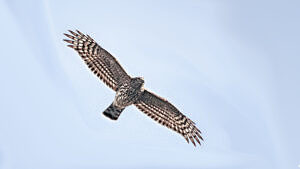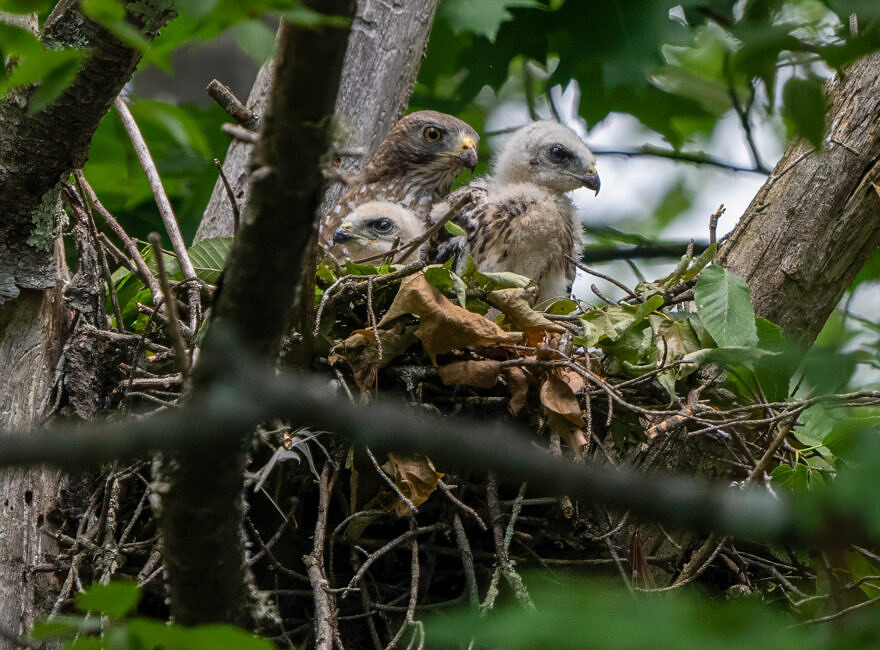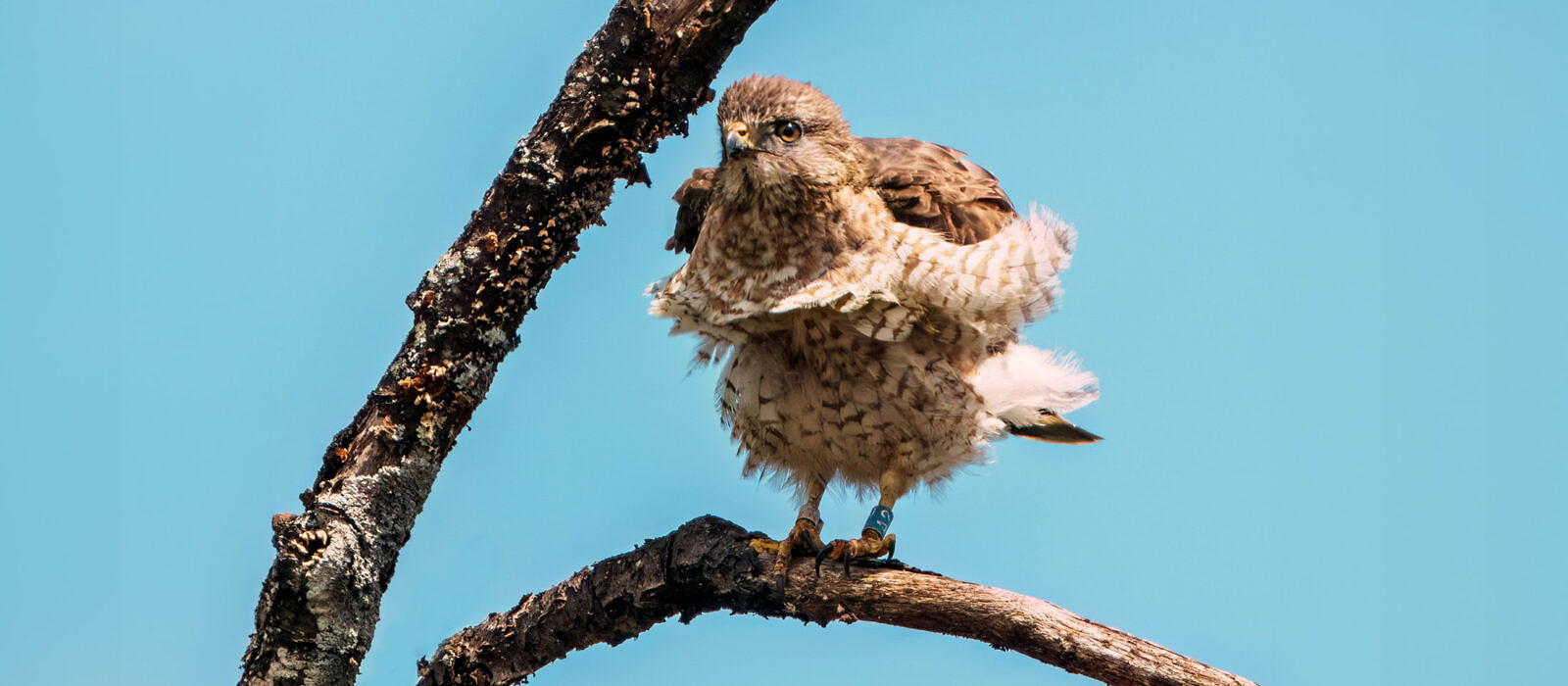Research & Stewardship for the Birds

In partnership with the Monadnock Chapter of Ducks Unlimited, Harris Center staff and volunteers installed 10 Wood Duck nest boxes on SuperSanctuary lands — including this one on our Hiroshi property — this year. (photo © Ben Conant)
Summer is always an exciting time in the SuperSanctuary, as this part of the Northeast is fortunate to have some of the highest breeding bird diversity in the country! Our expansive conserved lands protect woodland habitat favored by various species, including the American Goshawk, Broad-winged Hawk, and Wood Thrush, all species in decline that need contiguous woodland to thrive. Though they represent a small percentage of total land cover in the Monadnock Region, grasslands – largely in the form of hayfields and pastures – also provide vital breeding habitat for the declining American Kestrel. In addition, conserved wetlands (especially beaver ponds) are vital for waterbirds, including the colorful Wood Duck and Hooded Merganser, both of which will benefit from new nest box installations on Harris Center lands.
The Harris Center’s expanding bird conservation program plays a key role in monitoring, studying, and stewarding bird populations in the Monadnock Region, making a difference both locally and well beyond our borders. Here are just a few of the projects we’ve been working on this summer, with a special focus on raptors.
Our Kestrel Project Grows…

Master bird bander Lindsay Herlihy holds a kestrel chick, while Phil Brown removes another chick from the nest box behind her.
(photo © Brett Amy Thelen)
In 2024, the Harris Center expanded our American Kestrel conservation program by doubling the number of nest boxes associated with this project to a total of 45 boxes — primarily on private agricultural lands — across 19 towns in the Monadnock Region. Nesting kestrels also used more of these boxes than last year, a number that will hopefully continue to grow as each successful breeding season brings more kestrels into the world.
Thanks to the efforts of this fledgling program, six nest boxes fledged 24 nestlings this season, up from 17 last year. New landowners also got involved, fostering important conversations about how best to steward these critical grassland habitats. For a more detailed update, check out this ELF Magazine article by Bird Conservation Director Phil Brown.
American Goshawk Surveys

An American Goshawk in flight. (photo © Raven.Digital)
This spring and summer, Phil Brown and bird conservation intern Chris Liazos surveyed four American Goshawk territories in Stoddard, Hancock, and Peterborough. They used two survey methods: playing recorded bird calls (broadcast surveys) and setting out Audiomoths — small devices that automatically record sounds at set times (acoustic surveys). Taken together, these surveys identified three goshawk territories and five individual goshawks, including two pairs. We’ve also received additional goshawk reports and are maintaining a database of sightings in preparation for an upcoming regional conservation research project focused on the conservation of this species in decline. You can learn more about the acoustic surveys here.
Broad-winged Hawk Nest Monitoring

In 2024, Harris Center staff and volunteers documented six Broad-winged Hawk nests, following five to the point of fledging — including this one in Hancock. (photo © Chuck Carlson)
In partnership with Hawk Mountain’s Broad-winged Hawk Project, the Harris Center continues to track Broad-winged breeding in the SuperSanctuary. For the fourth consecutive year, Harris Center staff and volunteers identified and monitored nests, recorded productivity data, and collected other data on Broad-winged breeding habitat. This summer, we documented six nests, following five to the point of fledging. For the third year in a row, “Skatutakee,” the adult female Broad-winged Hawk who nests on the Dublin School campus, provided movement and migration data via a cellular transmitter affixed in 2022. Drama unfolded in late July as two of her chicks were found dead outside the nest, perhaps from a predator attack. Thankfully, Skatutakee has continued to tend her one remaining fledgling as of this writing in early August. We look forward to seeing where this long-distance migrant superstar goes later this summer, fall, and winter!
Pack Monadnock Raptor Observatory Celebrates 20 Years

Hawk watchers celebrate the 10,000th migrant raptor of the 2020 season. (photo © Cynthia Nichols)
On September 1, the Pack Monadnock Raptor Observatory will begin its 20th season of monitoring the fall raptor migration and educating thousands of visitors about “the greatest show above earth” from the summit of Pack Monadnock. This season, we welcome Caroline Fegley as the new Raptor Counter. From September through November, Caroline and other Harris Center staff and volunteers will document the fall raptor migration and share the spectacle and science of the migration with thousands of visitors.
This Harris Center project, in partnership with NH State Parks and the NH Department of Natural & Cultural Resources, operates daily from September 1 through November 20 near the summit of Pack Monadnock Mountain in Miller State Park in Peterborough, and visitors are welcome! You can learn more about the Observatory, including when to visit, what to expect, and current accessibility information, here.
Contact Us
For more information, please contact Bird Conservation Director Phil Brown at (603) 525-3394 or by email.


